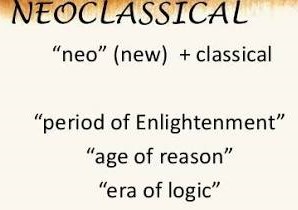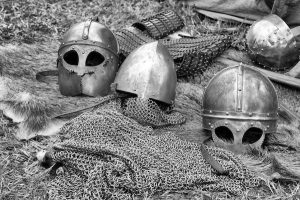The Anglo Norman Period / Middle English Poetry / Medieval Poetry / Middle English Period or the Middle Ages (1066—1485)
In 1066—The Anglo Norman Period—, a new group of warriors landed on England’s shore from Normandy, an independent state in France. The ruler of Normandy, Duke William, had claimed to be heir to England’s throne, but the throne had gone instead to Harold of Wessex—the Anglo Saxon king. So William led his army to England, where the Normans soon defeated and killed King Harold at the Battle of Hastings and conquered England. This event changed the course of English history, language, and literature.

A French England
Following the Norman Conquest, the Anglo Saxons became the subjects of a Norman Aristocracy. The Normans brought their social system called Feudalism, and their French language. Over time, these and other elements of French culture blended into Anglo-Saxon life to create a new English culture.
Under the system of feudalism, English society was divided into a clear-cut hierarchy—a social and economic ranking—with the king at the top. Under the king were the lords to whom the king allotted parcels of lands called fiefs, in return for their loyalty. In fact, soon after the conquest, king William distributed the estates of the defeated English landowners to about 180 of his followers, mostly Norman barons. Each lord supplied warriors, or knights, to the king.
The lords, in return, distributed tracts of land to lesser nobles in exchange for their loyalty. At the bottom were the serfs, who farmed small plots of land belonging to their lords and gave a portion of their crops to their lords. To secure his rule over all of feudal England, King William established a strong centralized government. One of his most significant acts was to order a detailed survey of all the estates in England either held directly by him or in fief from him.
The resulting inventory, known as the Domesday Book, was used to determine taxes as well as feudal rights and duties. Feudalism’s hierarchy was also reinforced by a code of conduct known as chivalry. Under the chivalric code, a knight pledged to be loyal to his lord at ay cost, to honour women, to protect the weak, to fight injustices and wrongs as defined by his lord, and to defend the Christian faith. This code was central to medieval social values and to the feudal hierarchy.
A New Language
After the Norman Conquest, England’s new aristocracy spoke mainly French. Well educated people needed to know three languages—French for dealing with the nobility or the courts; Latin for the church, business, and scholarship; and English for communicating with the majority of the common people.
French has a strong influence on English language. Many French works were added, and many Old English works were dropped. French influence also led to the gradual simplification of English grammar and spelling. Eventually, Middle English, a language in many ways similar to the English used today developed.
Conflict and Plague
Was life quite and simple in England during the Middle Ages? It certainly would not have seemed so to those who faced the period’s major developments—the religious warfare of the Crusades, intense political conflict, a century of war with France, and a raging epidemic.
The Crusades
Just as French influence pervaded England during the Middle Ages, so did the influence of the Roman Catholic Church. Between 1095 and 1270, the church sponsored a series of military expeditions to the Middle East, called the Crusades, to win Jerusalem, and the Holy Land from the Muslims. Some English nobles and knights took part in the Crusades. In 1190, King Richard-I of England known as Richard the lion-heart, helped lead the third Crusade. Ultimately, the crusades failed to win the Holy Land. However, they indirectly contributed to the weakening of the feudal power of kings and barons in England. To help finance the third Crusade, king Richard-I heavily taxed his barons often disregarding their rights. He further weakened the feudal system by selling privileges of self-government to barons. In addition, Richard was captured and held for ransom on his way home from the Crusade. Paying the ransom required further taxation, causing resentment towards the crown. This resentment would break out in open revolt under Richard’s successor.
Church vs State
Under the feudal system, the king also appointed bishops and gave lands to them. Some bishops held great estates and positions in the government. Not surprisingly, frequent clashes occurred over government and over church control in non-religious matters.
The struggle between King Henry II (the father of Richard I) and the priest Thomas A. Becket exemplifies this conflict. In 1162, Henry named Becket archbishop of Canterbury—head of the Roman Catholic Church in England. As archbishop, Becket opposed the king’s attempts to establish royal rights over the church, such as the right of royal courts to punish clerics who committed crimes. At one point, Henry raged, “Will no one rid me of this turbulent priest?” four knights took Henry’s words literally, and murdered Becket in Canterbury Cathedral, where he was praying. The murder shocked Christian Europe, and Becket was canonized as a saint. A shrine dedicated to Becket is the destination for the pilgrims in Geoffery Chaucer’s Canterbury Tales.
The Magna Carta
The England’s kings had conflicts not only with the church, but also with the feudal barons. When king Richard I (son of Henry II) died in 1199, he was succeeded by his brother, John. With the crown John inherited the resentment of the barons whom Richard had taxed heavily to help fund the third Crusade. John added to this problem by provoking a war with France in which he lost nearly all his possessions there, including Normandy. To finance that war and a subsequent military campaign to recover his losses, John had placed sever financial demands on his barons without consulting them. The barons revolted against John’s abuse of power, and in 1215 they forced him to sign a document late on called the Magna Carta. A milestone in the development of democracy, Magna Carta aimed to place the king under the law, and to protect the rights of free citizens.
The Hundred Years’ War
In a struggle for control of lands in France, the English and French fought a series of wars between 1337 and 1453. Together, these wars became known as the Hundred Years’ War. France was victorious, and England lost all its remaining territory in continental Europe, except for Calais, which was eventually taken over by the French. These wars took a tremendous financial toll on England. However, the break with France that resulted from the Hundred Years’ War helped England develop a new national identity, on that was not tied to France. Even before the war began, French influence on English society had begun to wane. After the loss of Normandy, English returned as the language of aristocracy, and before the wars were over, English had replaced French in the courts, Parliament, and official legal documents.
The Black Death
In the midst of Hundred Years’ War, an epidemic of bubonic plague, called the Bleak Death, swept through Europe. The plague first hit England in 1348, and then new outbreaks occurred over the next decades. Spread by the bite of an infected flea carried by rodents, the plague caused painful swellings, high fever, and body aches. Victims often died within five days of contracting the disease. The Black Death killed about one-third of England’s population.
The Rise of Cities
The Back Death would bring an unexpected change to the labouring class. As the Black Death caused a labour shortage, workers could demand high wages, and peasants could insist on lower rents on their plots of land. Some peasants even began leasing property and lending money, and were able, with their increasing income, to build stronger stone houses. While peasants’ income rose due to the labour shortage, landlords experienced a decline in revenues. This shift shook a feudal structure that had been changing for more than a century. More and more cities brought the right of self-government form kings Richard I and John, and towns began expanding through trade. People migrated to the cities, towns, and centers of commerce that were fast becoming sources of opportunity. The expansion of towns and the needs for different types of labour, combined with the lower classes’ rising assertiveness, helped break down the feudal hierarchy.
#The Anglo Norman Period #The Anglo Norman Period #The Anglo Norman Period #The Anglo Norman Period #The Anglo Norman Period #The Anglo Norman Period #The Anglo Norman Period #The Anglo Norman Period #The Anglo Norman Period




